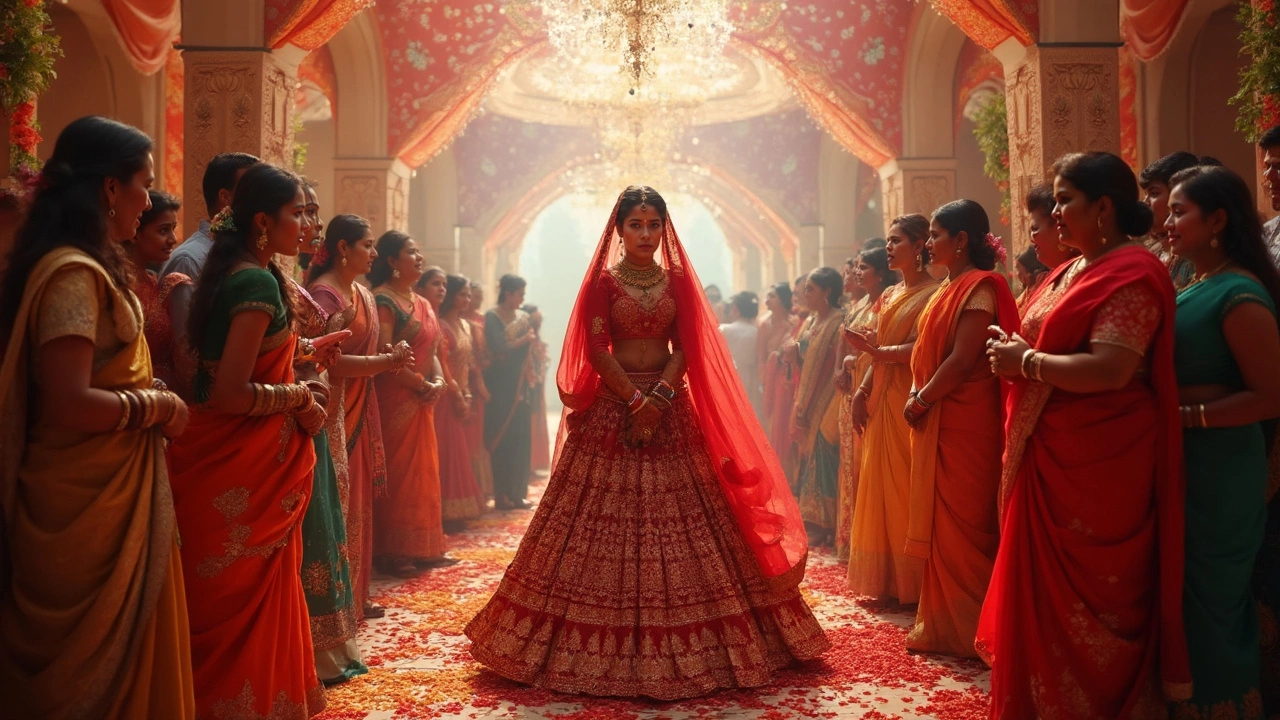
Planning a wedding can be both exciting and a bit stressful, especially when it comes to figuring out who foots the bill. Traditionally, wedding expenses have been divided based on long-standing customs, but let's face it—times have changed. Knowing who should pay for what can make the whole process a little less confusing.
The basic idea is pretty classic: the bride's family often covers a lot of the main costs. We're talking about the venue, the food, even the wedding gown. But, it's not all on them! The groom's family has their traditional share too, often handling things like the rehearsal dinner and sometimes the alcohol.
That said, today’s couples are rewriting the rules. Many now choose to split costs more evenly between both families, or even take on the expenses themselves. This shift is largely due to many couples getting married later in life or simply wanting more control over their choices.
- The Bride's Family Responsibilities
- The Groom's Side of the Bill
- What Today's Couples Are Paying For
- Split or Share: Modern Payment Practices
- Tips for Navigating Wedding Expenses
The Bride's Family Responsibilities
Traditionally, the bride's family takes on the lion's share of wedding expenses. It's one of those customs that has been around forever, stemming from when the bride's family would provide a dowry. While dowries aren't a thing anymore, the costs associated with a wedding can feel similar.
The Venue and Reception
The most significant cost the bride’s family typically covers is the wedding venue and reception. This can include renting a hall, a hotel ballroom, or even a cozy outdoor garden spot. Along with the venue itself comes all the associated expenses such as catering, decor, and entertainment.
Attire
In many instances, the bride's family is known to pay for the wedding gown, shoes, and accessories. Although trends are changing, and brides often choose to pay for their attire nowadays, it's still something to consider during planning.
Photography and Videography
There's nothing more important than capturing the day's memories. Traditionally, it's the bride's family who pays the bill for professional photography and videography services.
Flower Arrangements
Yes, those beautiful centerpieces and bouquets also fall under the bride's family list. Whether it's a grand floral installation or simple boutonnieres, the cost can add up quick.
| Expense | Percentage |
|---|---|
| Venue and Catering | 50% |
| Attire and Accessories | 15% |
| Photography/Videography | 20% |
| Flowers | 10% |
Invitations and Stationery
Another cost that traditionally falls to the bride's side is the invitations. This includes everything from creating and mailing the invites to printing programs and place cards.
While these customs have eased over time, understanding them can be a helpful starting point for couples wanting a traditional approach. At the end of the day, how costs are divided should be based on individual circumstances and discussions between families.
The Groom's Side of the Bill
When it comes to tackling wedding expenses, the groom's family has its own set of traditional responsibilities. Historically, this included some of the big-ticket items, though customs do vary quite a bit by culture and region.
One of the main costs associated with the groom's side is the rehearsal dinner. This is a chance for both families to relax, mingle, and prepare for the upcoming big day. It's traditionally hosted the night before the wedding and includes members of the bridal party and immediate families.
"The joining of two families is a beautiful tradition, and hosting the rehearsal dinner is one way to celebrate that union in a more intimate setting," says Jamie Lee, a renowned wedding planner based in London.
More on Traditional Costs
Aside from the rehearsal dinner, the groom's side often covers other expenses. These can include:
- The marriage license fees, which are thankfully not super pricey in the UK, usually under £100.
- The officiant’s fee, whether it’s a religious official, a hired celebrant, or even a close friend.
- Bouquets for the bride's and bridesmaids' flowers, traditionally handled by the groom—the logic being he's the one giving flowers on this special day.
- The honeymoon. In many cultures, the groom surprises the bride with a plan for their first escape as a married couple.
Modern Takes on Tradition
Today, many couples approach wedding planning with a fresh perspective. This could mean sharing costs equally, following the traditional route, or something completely different. Some grooms are even taking an active role in funding their own wedding attire, which wasn't always the case historically!
| Traditional Groom's Expenses | Average Cost Range (GBP) |
|---|---|
| Rehearsal Dinner | £1,000 - £4,000 |
| Marriage License | £35 - £95 |
| Bride's Bouquet | £40 - £150 |
| Honeymoon | £2,000 - £8,000 |
Ultimately, there's no one-size-fits-all approach. Couples need to communicate and decide what best suits their scenario. Understanding traditional roles offers a helpful starting point, but the ultimate goal is ensuring everyone feels comfortable and the day is as special as it should be.

What Today's Couples Are Paying For
Gone are the days when the bride's family footed the entire wedding bill. Today, it's common for couples to manage their own wedding budget or share expenses with both families. So, what are couples typically covering today?
The Venue and Catering
Usually, the largest chunk of any wedding budget goes to the venue and catering. With average costs in the UK hovering around £4,000-£5,000 for both, couples often prioritize a unique venue and tasty food over other expenses.
Attire and Accessories
Whether it's a designer gown or a tailored suit, attire can get pricey. On average, brides in the UK spend about £1,300 on their wedding dress, while grooms budget approximately £500 for their outfit. Expect additional costs for accessories and alterations.
Decorations and Flowers
Many couples want their wedding to reflect their style, and decorations play a big role in setting the mood. The average spend on flowers and décor clocks in at around £1,500. DIY approaches are becoming more popular to stretch the budget further.
Photography and Videography
Capturing the day is important, with many couples willing to invest in high-quality photography and videography. This category usually accounts for £1,500-£2,500 of the entire budget, depending on the package chosen.
Entertainment
Live bands, DJs, or even a mix playlist—entertainment is crucial for setting the party's vibe. Couples typically reserve around £1,000 for entertainment to keep guests on their feet.
While these expenses can add up, it's not just about tradition anymore. Today's wedding expenses reflect modern priorities and values, focusing on personalizing the experience rather than adhering strictly to old convention.
Split or Share: Modern Payment Practices
It seems like every couple approaching their wedding has their own way of dealing with money. The days of strictly defined rules have given way to a more flexible approach. Parents no longer automatically take on the entire wedding budget, and sometimes, they don't contribute at all. Let's look at how modern couples are handling wedding expenses.
One common trend is that couples are choosing to split costs more evenly between both sets of parents—especially if both families are financially capable. This method helps reduce financial strain on any single family member and can promote a sense of equality and partnership right from the beginning.
Couples Taking Charge
A growing trend shows that more couples are paying for their own weddings. According to a recent survey from 2023, about 55% of couples now contribute substantially to their wedding budget. Couples prefer this because it gives them more control over their choices—something that matters a lot when creating a day that's truly 'theirs'.
Sometimes, couples approach their families for specific contributions. For instance, they might ask parents to pay for the venue while handling other costs on their own. This can be a good compromise if one area of the budget is particularly large.
Informal Arrangements
Informal arrangements can also come into play. A brother might surprise with covering the DJ costs, or an aunt might take care of the flowers. This approach relies heavily on family dynamics and open communication, so make sure everything is discussed up front.
Consideration should also be given to each family's financial ability. A frank discussion early on can clarify expectations and prevent misunderstandings. For couples and families looking to save, there are numerous cost-saving tips and tricks available, from choosing off-peak wedding dates to DIY decorations.
Creating a Budget Everyone Is Comfortable With
It's not just about splitting costs; it's about understanding who is comfortable with paying for what. Open conversations and thoughtful agreements are key. Having a comprehensive plan helps avoid any awkward moments and keeps everyone on the same page.
- Assess everyone's financial comfort level.
- Discuss expectations and boundaries openly.
- Outline clear contributions from each party.
- Be flexible and open to alternative solutions.
The key takeaway? The traditional wedding budget roles are evolving, with many couples choosing what feels right for them, not just what's custom. This flexibility can make planning your big day just a bit easier, even if it's proof that weddings—much like marriage—are about compromise and collaboration.

Tips for Navigating Wedding Expenses
Sorting out wedding expenses can feel like a maze, but with a few straightforward strategies, you'll be set for smooth sailing. Here's what you need to know to keep things manageable and perhaps even stress-free.
1. Set a Realistic Budget
First things first, figure out how much you're comfortable spending. Sit down with everyone involved in financing the wedding—both sides of the family and the couple themselves—to make sure everyone's on the same page. Don't forget to add a little cushion for unexpected costs!
2. Prioritize Heavily
Not all wedding elements hold the same weight. Decide what matters most to you, whether it's the wedding venue, the dress, or maybe even post-ceremony eats. Splurge where it counts and save on the rest. For example, many couples find that DIY decorations can save a good chunk without sacrificing the vibe.
3. Consider Modern Payment Options
Traditions aside, today's couples often opt to split the costs, or even cover them entirely, reflecting the trend toward independence and later marriages. This approach allows for more flexibility and can alleviate potential conflicts.
4. Use Technology to Your Advantage
There are dozens of apps designed to help couples manage their wedding budget. These tools can track spending, offer budgeting tips, and even send reminders when payments are due. Keep everything in one place to avoid overspending.
5. Negotiate Wisely
Don’t be afraid to haggle a bit with vendors. Many are willing to offer discounts or add-ons to secure your business. Always remember—it's your day, but it's their livelihood. Being respectful and open can go a long way in getting a good deal.
Here's a snapshot of how typical expenses might break down:
| Expense | Percentage of Budget |
|---|---|
| Venue | 40% |
| Catering | 30% |
| Photography | 10% |
| Attire | 10% |
| Miscellaneous | 10% |
Every couple is unique, so tailor this guide to fit your needs—after all, the aim is to create a day filled with joy, not debts!



Comments
Post Comment